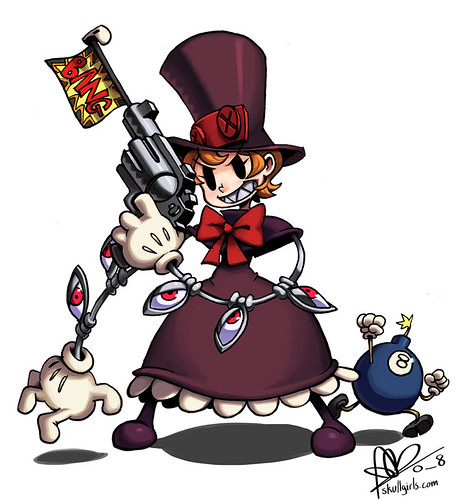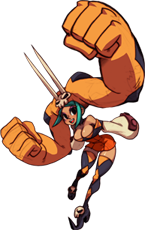On Animation in Skullgirls
April 19th, 2011
Written By: Mariel Cartwright
Hi, my name is Mariel, and I’m Skullgirls’ lead animator. I’ve previously worked on Scott Pilgrim vs The World: The Game and a number of titles from Wayforward. I thought I’d take the opportunity to share a few thoughts on the animation in Skullgirls.
One of the unique things about Skullgirls is that we’ve taken a hybrid approach to animation, combining elements from both western and eastern styles. What we’re trying to achieve is feature film-quality animation in a fighting game that draws on our influences and inspirations, while also bringing something new to the genre.
Everything in the game is animated by hand; there’s no Flash, 3D, or any other tools or assistance. Each frame is painstakingly sketched, inked, and colored by our team. Our animators come from traditional 2D backgrounds, many having worked on TV and films, and we’re taking what we’ve learned and applied it to a fighting game setting– something that I think provides a bit of a different perspective on how animation in 2D and indie games is typically handled. We’ve studied many of the games that inspire us, and combined that with our knowledge of animation to create seamless movement while retaining the punch and power fighting game animations need. Since we are a new team, we are of course still learning for ourselves what makes the animation in games like Street Fighter III: 3rd Strike and Darkstalkers so great, but I’m hoping that with Skullgirls we’ve found a good balance.
Most of us were raised on Japanese games and animation, but as western-trained animators, our sensibilities are quite different from our Japanese counterparts when it comes to actually animating things. While we’re obviously largely inspired by anime, our background in animation is more akin to how Disney’s animators are schooled, and so the way we approach animating results in a different look.
For example, much of Japanese animation focuses on key poses with follow-through animation, such as flowing hair and clothes, to create the motion. Western animation, on the other hand, is primarily focused on the overall motion and achieving as much flow with it as possible. Fighting games benefit from a more key pose-oriented approach to its animation, but I think we’ve been able to find a balance between strong poses and smooth animation that hopefully results in a unique look that separates us from other games.

Peacock here is a good example of how we’re taking our western influences and creating a whole character based on them– she is quite obviously inspired by classic American toons from the 20s and 30s, such as Betty Boop and Felix the Cat. Her motion, attacks, and overall look is unique to the genre and really exemplifies how we’re trying to make the game stand out, while also trying to retain the strong poses required for good fighting game animations.
As an additional note, the engine in Skullgirls allows us to be less conservative about the number of frames compared to most other contemporary 2D fighters, and as a result each character averages about 1300 fully hand-drawn frames. Because of this, we’re able to approach the game with more traditional animation in mind, and while we do have to keep certain frame counts so as to comply with gameplay needs, we’re allowed a lot of flexibility in choosing how to animate. We work this out with Mike, our lead programmer, as the animations are going in, to ensure that everything not only works best for gameplay but also looks as good as possible. We really hope that by combining everything we know and have learned from both western animation and Japanese anime and games, we’re able to create a game that looks and plays like nothing else.
Anyway, I hope I’ve been able to provide something insightful about how we’re approaching the animation in Skullgirls. Thanks for reading, and check back next Monday for another post from the Skullgirls team!







